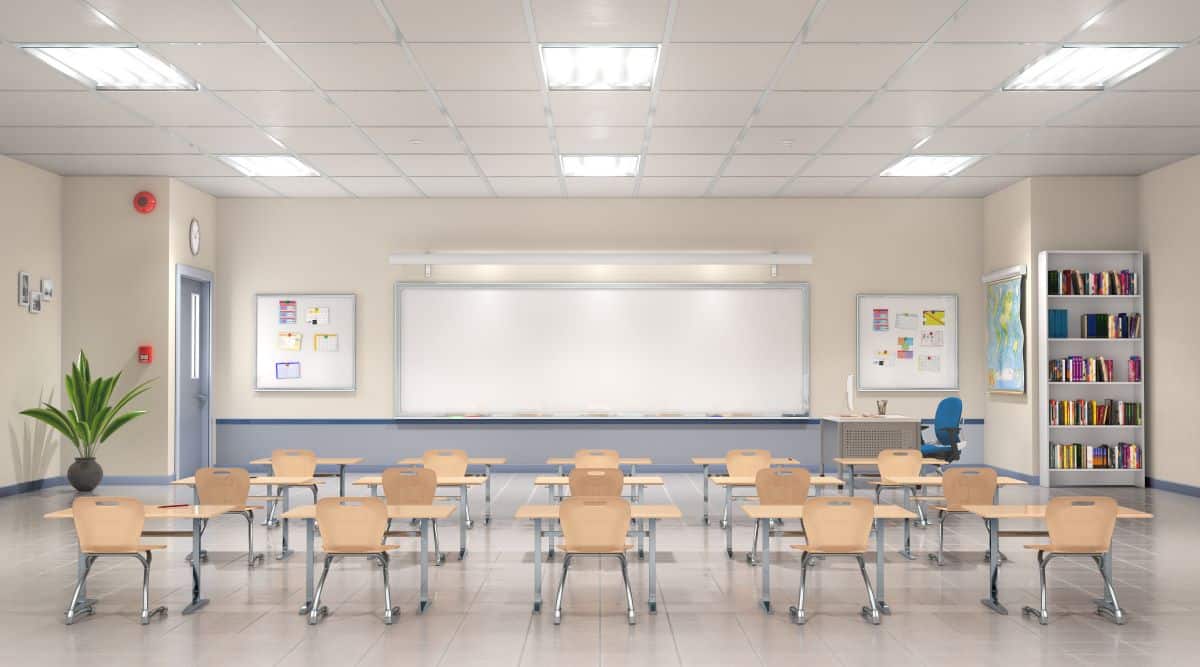By Jessica Irvine
LEDs (light-emitting diode) lights offer homes and businesses several benefits. The bulbs are energy-efficient and durable and improve lighting quality. LEDs also offer flexible lighting solutions.
K-12 schools also see these and other benefits. Students often improve academically after school’s upgrade to LED lights. It’s a cost-effective solution to lower energy usage costs and boosts student performance.
A History of LED Lighting in Schools
Before the 1930s, schools used sunlight. Artificial light was not widely available. An open-air movement in the 1930s and 1940s encouraged the addition of open spaces to improve the psychological and physiological well-being of students. It’s the start of schools implementing outdoor activities and physical exercise as part of the curriculum.
After WWII, the focus shifted to other design elements, primarily ventilation, heating, lighting, and acoustics. It’s when fluorescent lighting becomes the standard in most schools. However, studies are showing fluorescent lighting can have adverse effects on students. It’s one of the reasons schools are transitioning to LED fixtures.
Benefits of LED Upgrades for K-12 Schools
Here’s a look at the benefits of LED lighting in K-12 schools.
- Improving Student Performance in the Classroom
Multiple studies show installing LED lighting can improve academic performance. The lights can be set to mimic natural sunlight which improves concentration. Improved focus often leads to a boost in a student’s ability to learn and retain information.
LED lights can be tuned to white or blue light, depending on the time of the day. For example, younger students often have difficulty concentrating in the morning. Adjusting the LED lighting can help regulate natural biological rhythms, making it easier for students to focus.
Researchers are learning that LED lights can improve cognitive skills, reducing student error rates.
Professor Dr. Michael Shulte-Markwork, formerly the director of the Clinic for Psychosomatics in Children and Juveniles at the University Medical Centre Hamburg-Eppendoft conducted a one-year experiment studying the effects of light on students’ learning behavior. Working with 18 teachers and 166 students ranging in age from 8 to 16, he took baseline measurements and results using scientifically proven tests. A control group worked with standard lighting and the test subjects had dynamic lighting. Teachers were allowed to adjust the dynamic lighting to match the activity or time of day.
Teachers choose from four preset lighting controls:
- Normal: This setting was suitable for regular activities in the classroom.
- Energy: This setting could be used to invigorate the students when they were required to be more active, such as at the beginning of the school day or after lunch.
- Focus: The focus setting was designed to help students concentrate during challenging assignments.
- Calm: This fourth setting was designed to relax the students during individual assignments or quiet time.
The lighting systems used different color temperatures and light output, allowing for flexibility.
Some of the results of the experiment indicate:
- Improved Reading Speed: The students increased their reading speed by 35%.
- Improved Concentration: The students reduced their errors by 45%.
- Reduced Hyperactivity: When teachers gave students mathematical problems to solve, they used the Calm lighting scheme, which reduced the students’ hyperactivity by an astonishing 76%.
K-12 schools are not the only ones studying the effects of lighting. Numerous studies in the healthcare industry show that the use of LED lighting improves patient comfort and enhances staff performance.
Something else for schools with fluorescent lighting to consider is what to do with damaged or broken bulbs. Fluorescents contain mercury and schools must shut down until all traces of the hazardous material are removed from the campus. When an LED bulb breaks, schools only need to worry about broken glass. LEDs are free from hazardous materials.
- LED Energy Savings
Improving focus in the classroom is not the only benefit schools see by switching to LED lighting. Energy bills also decrease. LEDs use less energy than other types of lighting. Schools can also recycle LEDs, unlike fluorescent tubes.
According to the U.S. Department of Energy, switching to LEDs can reduce your energy consumption by 75 to 80 percent. By adding controls like times, dimmers, and sensors, schools can further reduce their energy costs.
Schools can further reduce energy costs when it comes to heating and cooling. Fluorescents emit more heat than light, unlike LEDs.
When your school is ready to upgrade to LED lighting, follow these steps to ensure a successful project.
- Conduct an audit: Gather data about your school’s energy consumption and present the information to your school’s decision-makers to get their support.
- Mock up an area of your school: Once you have the approval of your administration, mock up an area of your school with the LED lights that you proposed.
- Look for utility rebates: Speak with your local representative or distributor to find out if you qualify for utility rebates.
- Seek funding: In some situations, this could be the most difficult step. Your school may not have the money to upgrade all of its lighting fixtures at once. It may need to be installed in phases over a longer period.
Jessica Irvine is the director of marketing for Action Services Group, www.actionservicesgroup.com. With 30 years of experience as a national service provider, Action Services Group offers a single point of contact for all your facility services, project management, safety products, and EV charger needs.





